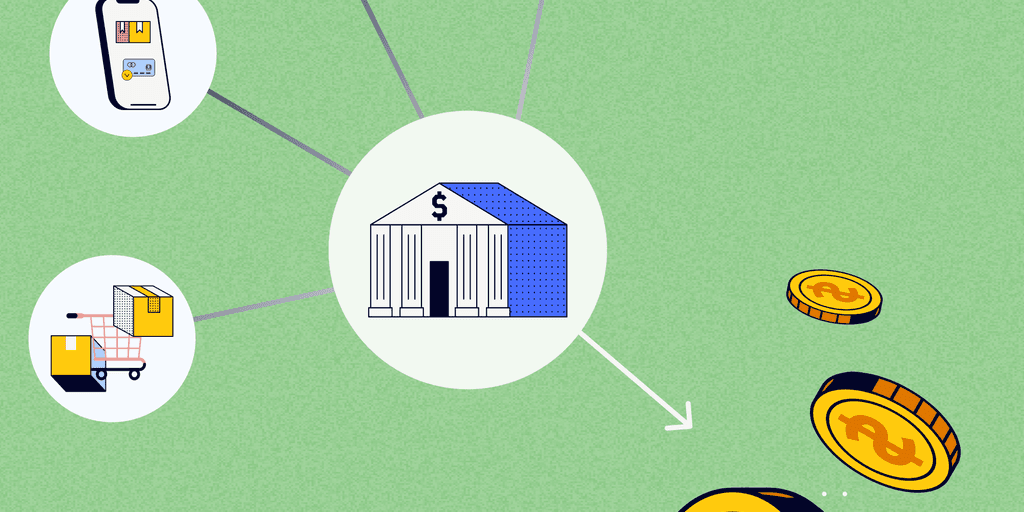
What Role Does the Merchant Acquirer Play in the Card Processing Ecosystem?
- 6 min read
In this article, you’ll learn the definition of a merchant acquirer and the role they play in the card processing ecosystem.
You’ll also learn:
How the merchant acquirer differs from the other players responsible for processing credit cards
How merchant acquirers interact with other players
The common misconceptions around acquirers, issuers, and payment processors

Your company probably accepts a large number of credit card payments from customers every month. The process may seem simple and straightforward—after all, a credit card payment is typically approved in a few seconds. But, there are actually several interactions happening between multiple players behind the scenes.
When you understand the role each of these players has, you can begin to spot ways to improve the speed, security, and cost associated with your credit card acceptance.
What is a merchant acquirer?
A merchant acquirer—also known as an acquiring bank, credit card acquirer, or acquirer—is the financial institution that enables a merchant to accept credit card payments.
An integral part of the payment processing flow, the acquirer is also responsible for settling card transactions for the merchant.
Where does the merchant acquirer fit in the lifecycle of a credit card transaction?
The merchant acquirer is one of several players involved in carrying out a credit card transaction. Let’s take a look at the lifecycle of a credit card transaction, to see where the merchant acquirer comes in.
Step 1: Payment information provided
The customer provides their credit card information to the merchant via card terminal, the merchant’s website, or over the phone.
Step 2: Card information routed
The credit card processor routes the credit card information through a payment gateway to the credit card network (e.g., Visa or Mastercard).
Step 3: Data sent to the issuing bank
The card network reaches out to the issuing bank (the cardholder’s bank), who reviews the transaction. The card network checks whether the customer has sufficient funds and decides to approve or deny the transaction.
Step 4: Issuing bank validates payment data
The approval or denial decision is sent back to the processor via the card network. The approval depends not only on whether the customer has sufficient funds, but also if the customer is suspected of fraud.
Step 5: Hold placed at the issuing bank
If the transaction is approved, the issuing bank places a hold on the payment amount. Note that the issuing bank, not the cardholder, is the one paying the amount. The cardholder pays back the issuing bank later with any applicable interest.
Step 6: Transactions settled
The merchant settles the batch of transactions at the end of every business day—a process that is facilitated by the payment processor.
Step 7: Funds released to the merchant acquirer
The approved transactions are sent to the issuing bank by the card network, who releases the funds to the acquiring bank.
Step 8: Merchant acquirer deposits funds
The payment processor directs the acquiring bank to deposit the funds into the merchant’s account, minus any interchange and credit card processing fees. These fees can quickly add up, contributing to many B2B merchants’ unwillingness to accept credit card payments. Luckily, there are ways you can reduce these costs, such as with credit card surcharging and interchange optimization.
Understanding the differences between acquirers, issuers, and payment processors
You need an acquirer, issuer, and payment processor to accept digital payments. These terms are often used incorrectly, however. To clear up some common misconceptions, we’ll examine the role of each player in the credit card transaction lifecycle.
Merchant acquirer vs. payment processor
The terms acquirer and payment processor are often used interchangeably, when in fact, they serve two separate functions.
Payment processors act as mediators between merchants, banks, and card networks. They record the payment information and forward it to the card networks and banks. In some cases, the processor also provides the payment terminal equipment a merchant uses to take payments in person.
The most sophisticated payment services providers can integrate with your Enterprise Resource Planning (ERP) software. In this case, you’re able to capture any payment, from any channel and house that data in one place.
The merchant acquirer maintains the merchant's account and deposits the funds. The payment processor does much of the heavy lifting by communicating back and forth with the card networks, issuing banks, and acquiring banks.
The acquirer and payment processor are typically two separate entities. In some cases, one entity—usually a large bank—acts as the acquirer and payment processor.
Merchant acquirer vs. issuer
There is also confusion about the differences between the acquirer vs. issuer.
The issuer, or issuing bank, is the cardholder’s bank. This entity is responsible for paying the merchant acquirer for approved card transactions and collecting payment from cardholders with any applicable interest.
So, the issuing bank is the bank that the cardholder is associated with. The acquiring bank is the bank that the merchant is associated with. The issuing bank takes on liability on the cardholder’s side and the acquiring bank takes responsibility for the merchant’s account.
Payment gateways and payment facilitators are terms that often get mistaken for the payment processor. For B2B businesses looking to accept payments online, it’s important you understand how these parties differ and the roles each plays.
The acquirer can provide other services to merchants
A credit card transaction is usually settled in a few seconds without issue. But in some cases, there are chargebacks, disputes, or requests for additional information. The acquirer often handles these issues and passes on the costs to the merchant.
With a chargeback, for example, there are processing costs which the acquiring bank may charge a per-transaction fee to cover.
The benefits of accepting more digital payments in B2B
There’s no better time to be increasing your acceptance of digital payments. Transitioning away from paper checks makes it easier for you to digitize more of your accounts receivable operations. In turn, you’ll give customers a greater experience, accelerate your cash flow, and drive more revenue.
Want to learn more about the ins and outs of credit card processing? Check out our Ultimate Guide to Credit Card Processing here.
About the author

Nick Vasco
Nick Vasco is a freelance writer who specializes in fintech. His previous experience as an FP&A analyst gave him an understanding of the challenges facing accounts receivable and finance professionals, helping him create content that solves their most pressing problems.


